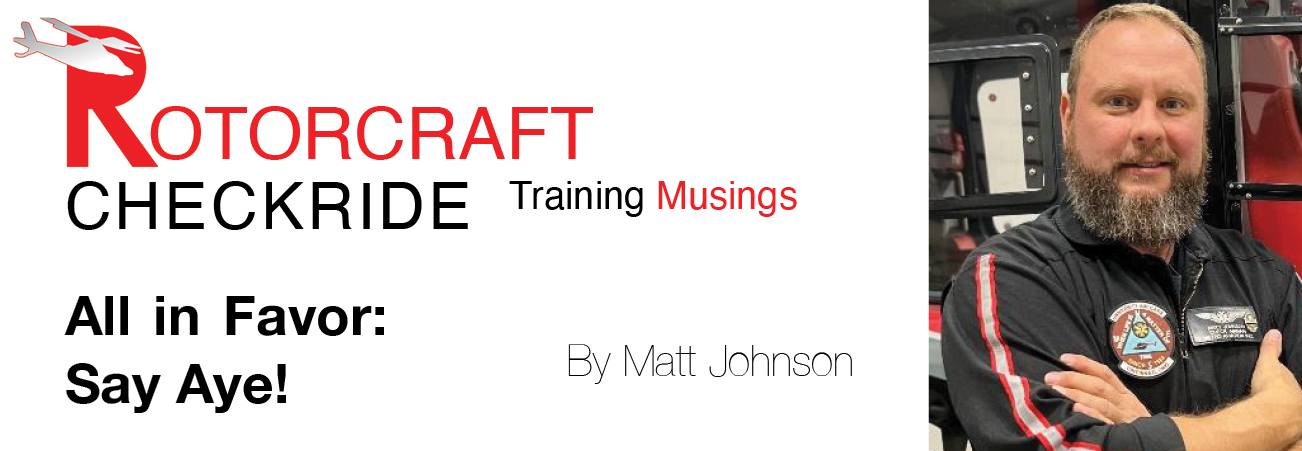|
Apr
22
2024
|
|
Posted 1 years 248 days ago ago by Admin
|
|

In case you have forgotten or haven't been bored enough to attend your local City Council meeting lately, "All in favor" is an idiom generally used to prompt the act of voting and typically exercised by either a voice response or a show of hands. And while it is just me writing this article, I will go out on a limb here and say "aye" for all three of us. That's how many (excluding friends and family) that want you to pass your Checkride! Obviously, you want to achieve that milestone, your CFI certainly has skin in the game, and designated pilot examiners want you to pass. Yes, you read that correctly! I, for one, and many of my other DPE colleagues I frequently network with, will agree that issuing a Notice of Disapproval is disappointing on our end as well. Remember, we are pilots too! We want to see you succeed! But first, a successful practical test stand upon three valid legs.
Consider this: every practical test stands (or sits, if you will) upon a three-legged stool. Often regarded as a symbol of stability, the three-legged stool analogy reminds us of balance (success) for its user when the three legs remain strong. Eliminate or weaken one of those legs, and the stool fails. In our world, as applicants, instructors, and pilot examiners, that balanced stool consists of the following three legs or items in order for a practical test even to begin. First leg: the applicant must be eligible for the test. Have all the aeronautical knowledge, proficiency, and experience requirements been met? On more than one occasion, I have had an applicant arrive for their practical test, and one or more of these elements have not been met. The logging of ground instruction required by the Part 61 regulations has been a frequently missed item over the past few years, and without it, the applicant isn't eligible. What about the experience (hour) requirements? Once again, it has been embarrassing for the applicant and CFI who arrived for a practical test and were found to be 0.2 hours short on an hour requirement or a few miles short on a cross-country requirement. Not only has that "leg" of the certification stool been weakened, but it proves very costly for the applicant who has possibly flown to the examiner for the practical test and the "re-do" of the cross-country needed to meet the requirements. One organization reported that one in five practical exams never even get started because the applicant is found to be ineligible for the practical test. Literally, 20% of available checkride slots are often wasted because a thorough review of the applicant's eligibility wasn't conducted. The “applicant leg” is most commonly the weak leg for all of the reasons stated, and I didn’t even broach the subject of correct endorsements (the subject of another article).
The second leg of our stool concerns itself with the aircraft being used for the test. It must be "airworthy" and all required aircraft "documents" must be present. While it is not uncommon for the applicant to help by pointing out the necessary inspection compliance in the various documents and logbooks, this phase is to establish that the aircraft is airworthy eligible by the examiner conducting the practical test. This is not the same maintenance records review required during the practical exam where an "applicant will review the aircraft maintenance records, logbooks, Airworthiness Certificate, and aircraft registration for the purpose of demonstrating aeronautical knowledge of how to determine whether an aircraft is airworthy" (from the guidance for examiners in 8900.1 Volume 5).
Sadly, I can recollect more than one applicant arriving with an aircraft that either lacked necessary documentation or inspections, knocking one of the three stable legs of the stool out of the equation, bringing about a collapse for the practical test to begin.
Finally, the third leg of the three-legged stool is yours truly, the examiner! Yes, we are held accountable by various regulations, orders, and oversight. We must be eligible to conduct the exam for a practical test to be valid. While I hold my designee status with the utmost respect and honor, I have long said that being a designated pilot examiner is not the glamorous position many people think it is. The applicant only sees what transpires on exam day; they don't see the amount of work that happens before and after a practical exam. The position requires a lot of effort to maintain all that is required, including yearly training, maintaining current plans of action, and our required observations. Fortunately, the FAA implemented the Designee Management System (DMS) several years ago, which acts as a conduit for all DPE functions and enables our FAA managing specialist to ensure we are up-to-date with all necessary training and observations.
Before a practical test can begin and thus even be "valid," the three-legged stool must be completely stable—hopefully, as stable as your flying on checkride day.
About the Author: Matt Johnson has been an FAA designated pilot examiner for over a decade, conducting exams ranging from Private to ATP and CFI. Additionally, he is a single-pilot IFR air medical captain and Part 135 instructor and check airman. He can be reached at [email protected] and via Twitter @HelicopterDPE
READ MORE ROTOR PRO: https://justhelicopters.com/Magazine
WATCH ROTOR PRO YOUTUBE CHANNEL: https://buff.ly/3Md0T3y
You can also find us on
Instagram - https://www.instagram.com/rotorpro1
Facebook - https://www.facebook.com/rotorpro1
Twitter - https://twitter.com/justhelicopters
LinkedIn - https://www.linkedin.com/company/rotorpro1